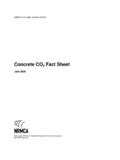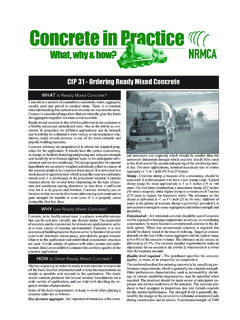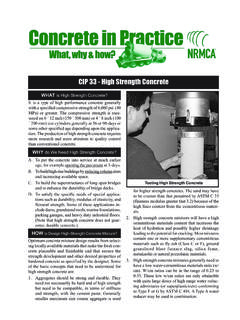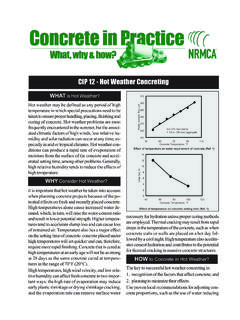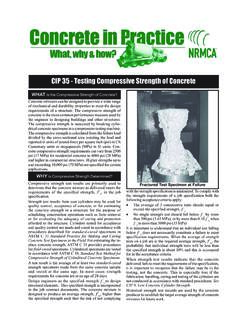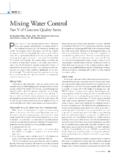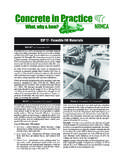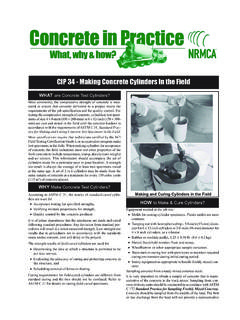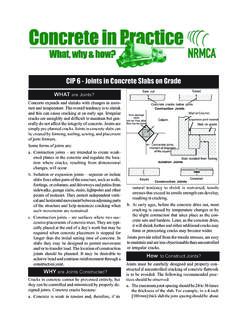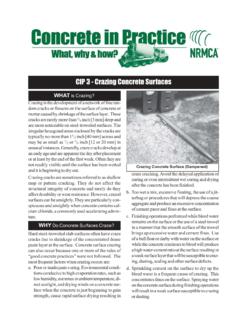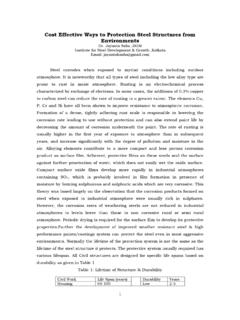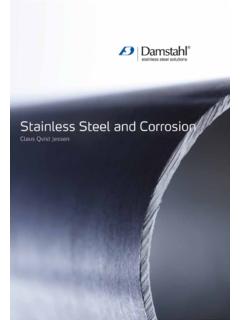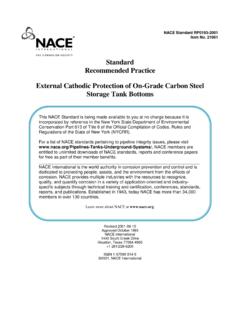Transcription of CIP 25 - Corrosion of Steel in Concrete
1 CIP 25 - Corrosion of Steel in ConcreteWHY is Corrosion of Steel a Concern?WHY Does Steel in Concrete Corrode?HOWto Prevent Corrosion ?ASTM terminology (G 15) defines Corrosion as thechemical or electrochemical reaction between a mate-rial, usually a metal, and its environment that producesa deterioration of the material and its properties. Forsteel embedded in Concrete , Corrosion results in theformation of rust which has two to four times the vol-ume of the original Steel and none of its good mechani-cal properties. Corrosion also produces pits or holes inthe surface of reinforcing Steel , reducing strength ca-pacity as a result of the reduced cross-sectional Concrete uses Steel to provide the tensileproperties that are needed in structural Concrete .
2 It pre-vents the failure of Concrete structures which are sub-jected to tensile and flexural stresses due to traffic,winds, dead loads, and thermal cycling. However, whenreinforcement corrodes, the formation of rust leads toa loss of bond between the Steel and the Concrete andsubsequent delamination and spalling. If left unchecked,the integrity of the structure can be affected. Reduc-tion in the cross-sectional area of Steel reduces itsstrength capacity. This is especially detrimental to theperformance of tensioned strands in prestressed in Concrete is usually in a noncorroding, passivecondition. However, Steel -reinforced Concrete is oftenused in severe environments where sea water or deic-ing salts are present.
3 When chloride moves into theconcrete, it disrupts the passive layer protecting thesteel, causing it to rust and of Concrete is another cause of Steel cor-rosion. When Concrete carbonates to the level of thesteel rebar, the normally alkaline environment, whichprotects Steel from Corrosion , is replaced by a moreneutral environment. Under these conditions the steelQuality Concrete Concrete PracticesThe first defense against Corrosion of Steel in concreteis quality Concrete and sufficient Concrete cover overthe reinforcing bars. Quality Concrete has a water-to-cementitious material ratio (w/cm) that is low enoughto slow down the penetration of chloride salts and thedevelopment of carbonation.
4 The w/c ratio should beless than to slow the rate of carbonation and lessthan to minimize chloride penetration. Concreteswith low w/c ratios can be produced by (1) increasingthe cement content; (2) reducing the water content byusing water reducers and superplasticizers; or (3) byusing larger amounts of fly ash, slag, or othercementitious materials. Additionally, the use of concreteingredients containing chlorides should be limited. TheACI 318 Building Code provides limits on the maxi-mum amount of soluble chlorides in the Concrete ingredient for good quality Concrete is air en-trainment. It is necessary to protect the Concrete fromWHAT is Corrosion of Steel ? Steel Corrosion on a bridge deckis not passive and rapid Corrosion begins.
5 The rate ofcorrosion due to carbonated Concrete cover is slowerthan chloride-induced , a lack of oxygen surrounding the steelrebar will cause the metal to dissolve, leaving a low to Limit Corrosion1. Use good quality Concrete -air entrained with a w/c of , or Use a minimum Concrete cover of inches and at least inch larger than the nominal maximum sizeof the coarse Increase the minimum cover to 2 inches for deicing salt exposure and to inches for marine Ensure that the Concrete is adequately Use fly ash, blast-furnace slag, or silica fume and/or a proven Corrosion and thawing damage. Air entrainment also re-duces bleeding and the corresponding increased per-meability due to the bleed channels.
6 Spalling and scal-ing can accelerate Corrosion damage of the embeddedreinforcing bars. Proper scheduling of finishing opera-tions is needed to ensure that the Concrete does notscale, spall, or crack correct amount of Steel will help keep cracks 224 helps the design engineer to minimize the for-mation of cracks that could be detrimental to embed-ded Steel . In general, the maximum allowable crackwidths are inch in deicing salt environments inch in marine cover over reinforcing Steel is also an im-portant factor. Chloride penetration and carbonation willoccur in the outer surface of even low permeabilityconcretes. Increasing the cover will delay the onset ofcorrosion.
7 For example, the time for chloride ions toreach a Steel rebar at 2 inches from the surface is fourtimes that with a 1 inch cover. ACI 318 recommends aminimum of inches of cover for most structures,and increases it to 2 inches of cover for protection fromdeicing salts. ACI 357 recommends inches of mini-mum cover in marine environments. Larger aggregatesrequire more cover. For aggregates greater than 3/4inch, a rule of thumb is to add to the nominal maximumaggregate size 3/4 inch of cover for deicing salt expo-sure, or 1-3/4 inch of cover for marine exposure. Forexample, Concrete with 1 inch aggregate in a marineexposure should have a 2-3/4 inch minimum Concrete must be adequately consolidated andcured.
8 Moist curing for a minimum of seven days at70 F is needed for Concrete with a w/c ratio,whereas six months is needed for a w/c ratio toobtain equivalent performance. Numerous studies showthat Concrete porosity is reduced significantly with in-creased curing times and, correspondingly, corrosionresistance is Concretes and Corrosion Protection SystemsIncreased Corrosion resistance can also come aboutby the use of Concrete additives. Silica fume, fly ash,and blast-furnace slag reduce the permeability of theconcrete to the penetration of chloride ions. Corrosioninhibitors, such as calcium nitrite, act to prevent corro-sion in the presence of chloride ions. In all cases, theyare added to quality Concrete at w/c less than or equalto repellents may reduce the ingress of moistureand chlorides to a limited extent.
9 However, ACI 222indicates that these are not effective in providing long-term protection. Since good quality Concrete alreadyhas a low permeability, the additional benefits of waterrepellents are not as protection techniques include protective mem-branes, cathodic protection, epoxy-coated reinforcingbars, and Concrete sealers (if reapplied every four tofive years).References1. Building Code Requirements for Reinforced Concrete , ACI318, American Concrete Institute, Farmington Hills, Corrosion of Metals in Concrete , American Concrete Insti-tute, Farmington Hills, Control of Cracking in Concrete Structures, ACI 224R,American Concrete Institute, Farmington Hills, Design and Construction of Fixed Offshore Concrete Struc-tures, ACI 357R, American Concrete Institute, FarmingtonHills, Perenchio, , Corrosion of Reinforcing Steel , ASTM STP169C, 1994, pp.
10 Whiting, D., ed., Paul Klieger Symposium on Performance ofConcrete, ACI SP-122, 1990, 499 Berke, , Corrosion Inhibitors in Concrete , Concrete In-ternational,Vol. 13, No. 7, 1991, pp. Berke, , Pfeifer, , and Weil, , Protection AgainstChloride Induced Corrosion , Concrete International, Vol. 10,No. 12, 1988, pp. 44-55.
